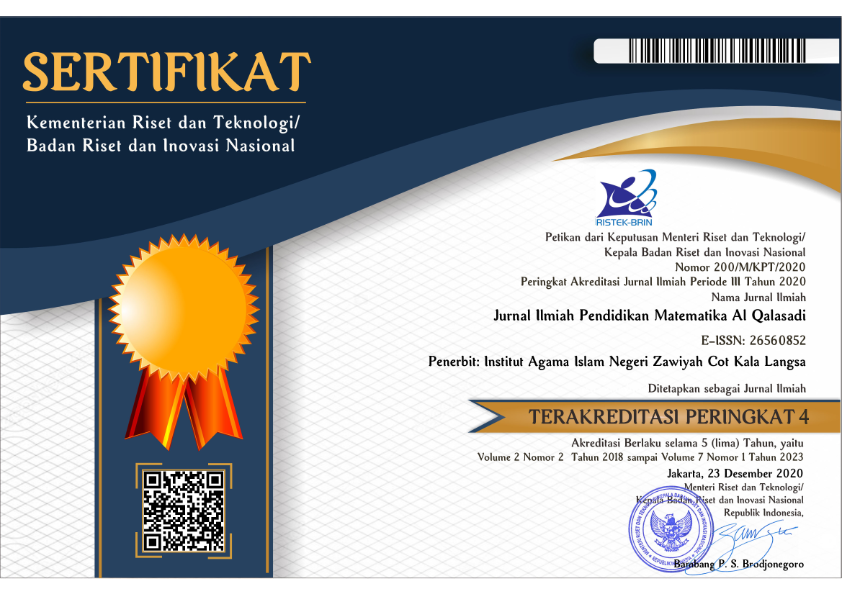Profil Berpikir Logis Siswa SMP dalam Menyelesaikan Soal Asesmen Kompetensi Minimum (AKM) Numerasi Konten Aljabar
Abstract
Logical thinking is the process of drawing conclusions based on facts through systematic steps and relevant arguments. This ability can be developed through mathematics learning, especially in problem-solving. This study aims to describe the logical thinking profile of junior high school students in solving AKM numeracy problems in algebra content.The research employs a descriptive method with a qualitative approach. The research instruments consist of two AKM numeracy problems related to systems of linear equations in two variables (SPLDV) and number patterns, as well as a validated semi-structured interview guide. Data were collected through a logical thinking test and interviews to identify indicators of logical thinking, namely coherence in reasoning, argumentation ability, and conclusion drawing. The test was administered to 30 eighth-grade students from SMP Negeri 1 Genteng. The results showed that two students met all indicators of logical thinking. These students were able to understand the problem by clearly writing down important information using their own words. They planned their solutions logically, applying the elimination and substitution methods for SPLDV problems and identifying number patterns in different ways. Their problem-solving steps aligned with Polya’s stages: understanding the problem, planning, implementing, and reviewing. Both students wrote conclusions supported by logical reasoning.
Downloads
References
Andiani, D., Hajizah, M. N., & Dahlan, J. A. (2020). Analisis Rancangan Assesmen Kompetensi Minimum (AKM) Numerasi Program Merdeka Belajar. Majamath: Jurnal Matematika Dan Pendidikan Matematika, 4(1), 80–90.
Andriawan, B., & Budiarto, M.T. (2014). Identifikasi Kemampuan Berpikir Logis dalam Pemecahan Masalah Matematika Pada Siswa Kelas VIII-1 SMP Negeri 2 Sidoarjo. MATHEdunesa, 3(2), 42–48.
Brata, D. P. N. (2024). Implementation of Pancasila Learner Profile-Based Attitude Assessment in Junior High School Civics Study Field Based on Phase D in the Independent Curriculum Era. EDUTEC : Journal of Education And Technology, 7(4), 303–311.
Devianti, D., & Hakim, D. L. (2021). Kemampuan Berpikir Logis Matematis Siswa Smp Pada Materi Aritmatika Sosial. MAJU: Jurnal Ilmiah Pendidikan Matematika, 8(1), 304–312.
Irwandi, B., Roza, Y., & Maimunah, M. (2022). Analisis Kemampuan Literasi Statistis Peserta Asesmen Kompetensi Minimum (AKM). Jurnal Gantang, 6(2), 177–183.
Kurniati, D., & As’ari, A. R. (2017). Disposisi Berpikir Kritis dalam Pembelajaran Matematika. Jakarta: Duta Media Publishing.
Kurniati, D., Hanim, S. V., Oktavianingtyas, E., Susanto, S., & Jatmiko, D. D. H. (2023). Proses Pemecahan Masalah Numerasi Tipe Uraian Pada Materi Spldv Berdasarkan Tahapan Polya. Sigma, 9(1), 25.
Loin, I., Mamoh, O., & Nahak, S. (2021). Analisis Kemampuan Berpikir Logis Siswa SMPS Katolik Aurora Pada Penyelesaian Soal Matematika. Asimtot: Jurnal Kependidikan Matematika, 3(2), 157–165.
Ningsih, T. R., & Bharata, H. (2021). Analisis Kemampuan Berpikir Logis Matematis Peserta Didik SMA Dalam Memecahkan Masalah Matematika Pada Materi Geometri Ruang Dalam Pembelajaran Jarak Jauh Di Tengah Pandemi Covid-19. JEMS (Jurnal Edukasi Matematika Dan Sains), 9(2), 457–468.
Nisa, S. C., Suprapto, E., & Sari, E. (2024). Identifikasi Kemampuan Berpikir Logis Dalam Pemecahan Masalah Matematika Pada Siswa Kelas XI SMAN 6 Madiun. Journal on Education, 6(4), 19945–19956.
Polya, G. 1973. How to Solve It (New of Mathematical Method). Second Edition. New Jersey: Prence University Press.
Sukhanova, N. P. (2021). Logic as a tool for developing critical thinking. Problems of Modern Education (Problemy Sovremennogo Obrazovaniya), 2, 19–26.
Wulandari, L., & Fatmahanik, U. (2020). Kemampuan Berpikir Logis Matematis Materi Pecahan pada Siswa Berkemampuan Awal Tinggi. Laplace : Jurnal Pendidikan Matematika, 3(1),43–57.
Copyright (c) 2025 Lailatul Hikamah, Dian Kurniati, Ervin Oktavianingtyas, Nurcholif Diah Sri Lestari, Dhanar Dwi Hary Jatmiko

This work is licensed under a Creative Commons Attribution 4.0 International License.
Copyright Notice
Authors who publish with this journal agree to the following terms:
Authors retain copyright and grant the Jurnal Ilmiah Pendidikan Matematika Al Qalasadi of first publication with the work simultaneously licensed under a Creative Commons Attribution License (CC BY 4.0) that allows others to share the work with an acknowledgment of the work's authorship and initial publication in this journal.
Authors are able to enter into separate, additional contractual arrangements for the non-exclusive distribution of the Jurnal Ilmiah Pendidikan Matematika Al Qalasadi published version of the work (e.g., post it to an institutional repository or publish it in a book), with an acknowledgment of its initial publication in this journal.
Authors are permitted and encouraged to post their work online (e.g., in institutional repositories or on their website) prior to and during the submission process, as it can lead to productive exchanges, as well as earlier and greater citation of published work (See The Effect of Open Access)







